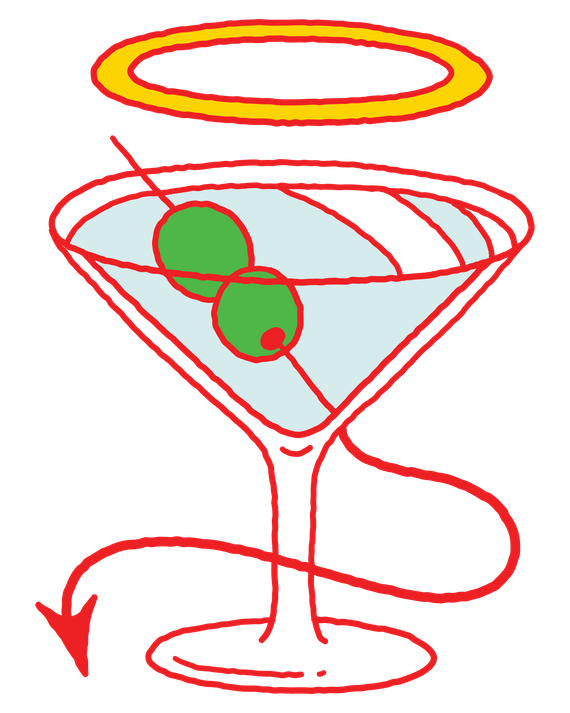
Are Americans drinking less? Alcohol sales and Gallup surveys suggest shifting attitudes among Gen-Z drinkers; restaurant and bar owners are, if not panicked, at least left to wonder how to cater to these changing tastes in an industry built around booze sales. The owners of the new bar Golden Ratio have come up with a novel answer: Split their 32-drink menu right down the middle between traditional cocktails and spirit-free counterparts.
“People want something interesting to drink — they don’t need to necessarily have alcohol anymore,” says Piper Kristensen, a partner and the beverage director for Redwood Hospitality, the restaurant group opening the bar (who also run Laurel Bakery, Place des Fêtes, and Cafe Mado). “But I don’t think that the demand is there to sustain a totally nonalcoholic bar.”
The bar itself, which they’re aiming to open during the first week of November, is a corner space in a former bodega a couple storefronts down from Place de Fêtes. They’ll be able to seat 50 to 60 people, and they have an all-electric kitchen with a food menu heavy on vegetables. For the drinks, every alcoholic option will have a nonalcoholic counterpart (and vice versa), but they won’t be one-to-one matches. They’re more like kissing cousins, and each is built around a specific ingredient, such as purple shiso. A nonalcoholic version pairs lemon-verbena distillate with a tea made from the shiso stems. The fizzy drink is served in a wine glass, smelling and tasting a little like toasted bread, which is also used to make the drink. The alcoholic version is a tart, light sour with spiked with a spirit made of green fennel seeds by the group’s house distiller, known as Acid Joe, who turns kitchen scraps — orange rinds, olive brine — into the spirits that show up across the menu.
Acid Joe, whose real name is Joe McDowell, makes his spirits by macerating and infusing ingredients into a neutral grain spirit from New York Distilling — he can’t distill straight from grain yet himself — using “corny kegs” with some carbon-dioxide pressure to expedite the press. That all gets squeezed through a cider press, then re-distilled. (Some experiments haven’t been entirely successful, like the finger lime shells leftover from a fluke dish.)
”I’m trying to take up as much of Joe’s bandwidth as I can,” says Kristensen, who tries to focus his drinks on “singular flavors” as much as possible, which is why he tends to veer away from conventional products made with “20 different botanicals.” Apples are a particular fixation of his, so Golden Ratio will offer dueling appletinis. One version starts by infusing apple skins into Cyril Zangs 00 eu de vie — “it helps to soften the edge a little and make it a little more palatable,” Kristensen says — while the nonalcoholic version is a shaken cocktail built around juice made from Ashmead’s Kernel apples, a lumpy variety favored for cider making. t’s a bit milky, with some texture from the tannins courtesy of some Concord grape. “I wanted it to taste like eating an apple at the market,” Kristensen says.
As much as he can, he’s trying to evoke specific ideas with his drinks. Spirits are an easier sell in that regard: “The reward is the rush your body gets,” Kristensen says, “but with nonalc drinks, I think you can really push people’s palates and bring nuanced, complicated flavors, and that will be part of the reward.” The last pair of drinks we try are built around a wild cousin of the Sichuan peppercorn called the toothache tree. Golden Ratio makes a syrup from the leaves, which aren’t numbing but do give the drink a refreshing, vegetal edge. The nonalcoholic option features a syrup made from the tree wood itself, plus a tea of goldenrod flowers. “It has this aroma and flavor that is very much like right now,” Kristensen says, “kind of the end of summer, beginning of fall”
They make a syrup from the leaves, which aren’t numbing, but which gives the drink a citrusy, vegetal flavor that’s quite refreshing. They double down on that with more of the spice bush alcohol distilled by Acid. Its nonalcoholic counterpart features a syrup made from wood of the toothache tree, lime hydrosol to emphasize the citrus, and tea of goldenrod, a plant with stunningly yellow flowers. “It has this aroma and flavor that is very much like right now, kind of the end of summer, beginning of fall.”
Thank you for subscribing and supporting our journalism.
If you prefer to read in print, you can also find this article in the October 20, 2025, issue of
New York Magazine.
Want more stories like this one? Subscribe now
to support our journalism and get unlimited access to our coverage.
If you prefer to read in print, you can also find this article in the October 20, 2025, issue of
New York Magazine.
EAT LIKE THE EXPERTS.
Sign up for the Grub Street newsletter.
Vox Media, LLC Terms and Privacy Notice

